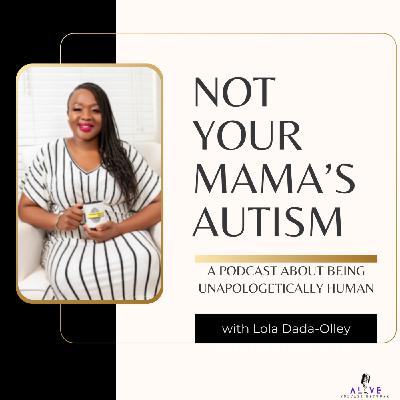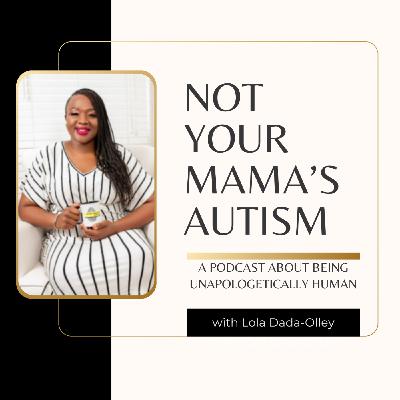Better Understanding Challenging Behavior: A Talk with Larissa Heise, BCBA
Update: 2025-04-01
Description
Summary
In this episode of Not Your Mama's Autism, host Lola Dada-Olley speaks with licensed social worker and BCBA Larissa Heise about the complexities of challenging behavior in neurodivergent individuals. They discuss the definition of challenging behavior, trends observed in recent years, the importance of identifying triggers, and the role of sensory needs. Larissa emphasizes the need for individualized approaches to support, the common misconceptions surrounding challenging behavior, and the importance of understanding the full context before implementing interventions. The conversation also covers strategies for navigating support systems and the significance of insurance in accessing professional help.
Takeaways
- Challenging behavior varies in definition and context.
- Challenging behavior often exceeds a family's ability to support.
- Safety concerns are a primary focus in identifying challenging behavior.
- Attention-seeking behavior is often misunderstood; it is about connection.
- Sensory needs can become more complex as individuals grow older.
- Understanding individual needs is crucial for effective support.
- Misconceptions about challenging behavior can lead to ineffective interventions.
- Gradual approaches are necessary for managing triggers and interventions.
- Reassessing strategies is important when previous methods stop working.
- Navigating insurance and support systems is essential for accessing help.
Chapters
00:00 Understanding Challenging Behavior
02:59 Trends in Challenging Behavior
06:06 Identifying Triggers
09:06 Complex Sensory Needs
12:00 Misconceptions About Challenging Behavior
15:05 Approaching Triggers and Interventions
19:04 Reassessing Strategies
24:03 Navigating Support Systems
35:55 Getting Started with Professional Help
Transcript
Lola Dada-Olley (00:02 .364)
Larissa Heise, thank you. Thank you for being on the Not Your Mama's Autism podcast today.
Larissa Heise (00:10 .317)
Thank you for having me.
Lola Dada-Olley (00:13 .148)
So you are a licensed social worker. You are also a BCBA for those listening who don't understand what that acronym means. In these neurodivergent streets, it means board certified behavioral analyst.
I am going to really enjoy this episode talking to you about behavior. So let's talk about challenging behavior. But before we do so, let's do some level setting. Because challenging behavior means different things to different people. So what would you identify as a challenging behavior?
Larissa Heise (00:57 .485)
I'm going to give you my personal definition and then I'm going to give you like what I think out in the world people are like generally having consensus on. Given the work that I do, I work a lot with family, families and very, a very parent centered model of support in the work that we do and some of the programs I supervise, very unique programs actually compared to maybe some other providers who are very family centric kind of approach to treatment.
I look at challenging behavior as being something that exceeds the family's ability to support. And that can mean different things for different people. I've had some families who are dealing with the more traditional definition of challenging behavior, which I'm going to share, but I've had other families who, you know, maybe it's not at a level of safety, but they are so overwhelmed. They still don't know what to do. And it's leading to
ER visits and things like that. But in terms of like what I think most people as a provider, right, most people would kind of agree upon in terms of challenging behavior are behaviors that are at risk of safety concerns. You know, generally we're looking at things where people are harming themselves, are at risk of harming others, are extremely dysregulated to the point where they're having a difficult time day to day.
in their lives, whether that's across settings. Typically we are seeing if somebody has kind of challenging behaviors or behaviors of concern, they're exhibiting them across settings and it's really impacting their quality of life usually in multiple ways. So it can look different, right, across age, situations, settings, but that's generally what I think, you know, the provider community is looking at. It's like behaviors that put people at risk of harm.
or limit their ability for quality of life.
Lola Dada-Olley (02:59 .388)
Well, thank you for level setting. Cause I think in the past, it might have been what you just described plus behaviors deemed quote unconventional by perhaps neurodifficult. And that to me are not the type of behaviors that should be prioritized in any way as.
Larissa Heise (03:11 .532)
Yeah.
Larissa Heise (03:18 .111)
Yeah, no, there are behaviors that make people uncomfortable. There's behaviors that people don't understand, right? But when we're talking about challenging me, we're talking about, really, I want to anchor it to like safety, safety concerns and things that are impacting the individual's quality of life, not necessarily somebody's perception of quality of life,
Lola Dada-Olley (03:25 .276)
Mm -hmm. Mm -hmm.
Lola Dada-Olley (03:44 .091)
Yep. So, looking at that as the level setting, what trends have you seen in your practice concerning some of the most common types of challenging behaviors that people, caregivers, educators are experiencing, are witnessing, I should say?
Larissa Heise (04:08 .469)
I think recently especially, feel like in last five plus years, there's been so many difficult things in the world that have impacted everyone. And we've seen quite a bit of increase in behaviors where people are at risk for immediate danger. I would say there's always different levels, Behaviors, a lot of people I talk to, they're like, comes out of nowhere.
Lola Dada-Olley (04:24 .038)
Yeah.
Larissa Heise (04:39 .105)
That's very unusual for it to actually come out of nowhere. Usually it builds up over time, right? So we usually see people start the lower levels of behavior of kids who, if they're unable to communicate in like a traditional sense, they have a difficult time getting their needs met. We're seeing behaviors where they're finding ways to get their needs met. People get their needs met any way they can, right? And that might include hitting, biting, kick -gagging, throwing things. lot of property destruction is typical.
crying as kids get older. Oftentimes we see if those behaviors aren't supported or we're not giving ways to get those needs met or teaching ways to get those needs met. We can see them intensify right and so. Kids get bigger. And sometimes depending on their individuals like. Skill level or ability to communicate.
Lola Dada-Olley (05:29 .19)
Yeah. Yeah.
Larissa Heise (05:36 .663)
they might still use those behaviors to get their needs met, but they're in a much bigger body now, right? They're adults or they're teenagers and they still need to find ways to get their needs met. And those behaviors, even if they're exactly the same as they were when they were younger, can be very different in terms of safety as people grow older. generally like those kinds of things. And I would say it's across settings. think, you know, different...
people in different places, like in home versus school, have different resources. So maybe there's more to support in different areas, but oftentimes, like, not always, but more often than not, we are seeing those more intensive behaviors across all different places.
Lola Dada-Olley (06:25 .81)
So when you mentioned earlier that you said certain, some people say it quote, comes out of nowhere, but in your practice, you've actually seen that that's almost not, almost always never the case. Could you give me an example of maybe a trigger that maybe most people don't notice that after maybe you all have kind of traced back the steps, you've discovered that this particular trigger is something that.
Larissa Heise (06:53 .122)
Yeah.
Lola Dada-Olley (06:56 .413)
folks should look deeper into.
Larissa Heise (06:57 .099)
Yeah.
I think there are triggers that think a lot of people pick up quickly, right? And then there's the sneakier ones. But a lot of people, can usually tell like, it's because I set a limit or I said, no, we can't do that right now. We have to wait. Like those are common things or, you know, things like that. But I feel like if somebody has like a complex sensory profile, a lot of people assume
Lola Dada-Olley (07:09 .702)
Yeah.
Larissa Heise (07:29 .217)
behaviors are, that's attention. I will say this, attention is not a bad thing. I always try to reframe that for people like attention is connection. People are seeking connection, maybe they're doing that in ways that maybe want to shape that to a different, you
Comments
In Channel
















